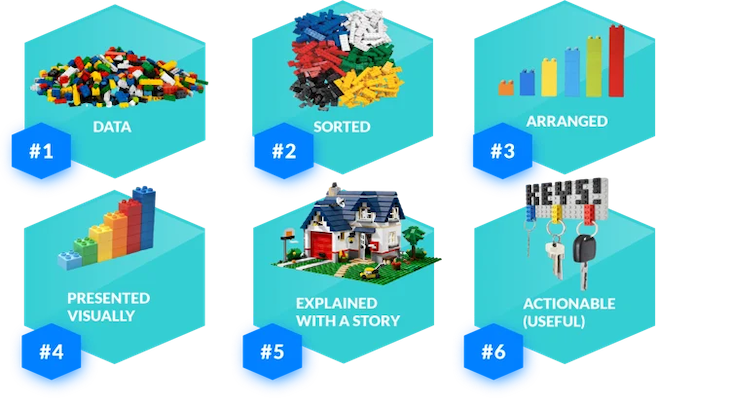Data is everywhere, offering a deeper understanding of products and services, providing insights into user behavior and interaction, and shaping new perspectives on vision, strategies, and roadmaps. How we use the data is evolving daily with machine learning and artificial intelligence.

In product management, one crucial use of data is creating product insights, offering product managers the opportunity to develop and build products to solve user problems and meet their needs. Understanding is the basis for constructing good actionable insight, and a solid grasp of product analytics will help you become a successful product manager.
Product analytics refers to the process of collecting, measuring, and evaluating data to drive decision making during product development.
Every product, even in the idea phase, has a potential way to gather data. Even if you don’t yet have a tangible product, you can obtain data from user interviews and competitor analysis. With an actual product, you have a mine of raw data, which is the core of product analytics, but that’s just one part of the process. You can define the data collection approach in three ways: descriptive, predictive, and prescriptive analytics.
Product analytics is broader than just collecting data. Raw data is of no use unless it is placed in the proper context. Let’s take an example of a fashion app with more than 2 million active users every month. Does this data signify that the app is doing well, or if the app needs any improvement? No, it simply indicates that the app has many users trying to use the service.
Now, let’s take this example a step further into analyzing where we compare month-on-month active user data and try to see a trend if it’s increasing or decreasing or is stagnant. These insights that are gathered from analyzing the data are a part of product analytics.
In many organizations, there is an established way to gather data and a process to analyze the data, but usually, what is needed is a way to turn those analytical findings into actionable insights. You can only make a data-driven decision if you have the competence to analyze the data and convert it into actionable insights.
An actionable insight can be defined as a specific action derived from deeper data analysis. When a product manager makes an informed decision about the next step based on data combined with his expertise, that is actionable insight.
Continuing on the above example and taking it one step further, if the analysis is made by identifying the time of the month when there are peak active users and comparing it with average order value, we can gain actionable insight into the effort and marketing strategy or campaign spends to enhance the customer experience. To determine the impact, we can measure success using increased AOV as a KPI.
The data is the baseline where we can see all the numbers. Insights are when we analyze data and form a conclusion. Actionable insight is when we mix our expertise with data and develop an implementation hypothesis to improve the results.
Actionable insights are crucial for:
Being data-driven might not be the clear roadmap to innovation, but it certainly provides perspective on the magnanimity of the problem.
With actionable insights, the product managers can decide with certainty and not only based on gut feeling, assuring them of reliability about the next steps.
While working with new products, knowing how the customer will perceive every functionality can be challenging. Iterative development allows the product team to develop with minimum effort, learning faster from the data and obtaining actionable insight, which helps the team to adapt and continue the action in the right direction. It avoids waste of time and resources, enabling optimal efficiency.
It’s common to have a backlog filled with multiple ideas that seem promising. However, with the help of actionable insights and product analytics, it becomes easier for product managers to correctly identify and prioritize the most valuable item.
Product teams can maximize their time and effort with proper prioritization and iterative development. It doesn’t guarantee they will develop all the right features, but experimentation and learning are necessary to innovate.
This approach allows for faster and smaller learning costs. Product teams can quickly determine what works and what doesn’t, guiding them towards the right direction.
Actionable insight is powerful and undeniable; hence, everyone is aligned on the strategy, creating more focus on synchronization and delivery. Plans derived from actionable insights are easy to communicate and get the buy-ins from all fronts.
Every product needs a good story with a background plot, a problem, a solution, and a satisfying end. Similarly, when working with product analytics, it’s wise first to define the situation you are dealing with and the reason why you started analyzing it in the first place.
Defining a clear objective means describing why and associating it with the vision and how solving this objective will get the product closer to its goal. This approach will help everyone stay focused on the bigger picture and avoid getting sidetracked by corner cases. It will also set the stage and bring everyone on the same page of understanding.
For this, we will take an example of the number of visitors to our shopping app and the conversion rate, meaning how many people go from browsing to adding items to the cart to carrying the checkout process.
Let’s say we have 2 million monthly active users on our shopping app every month, out of which 800,000 of them add products to their cart, and 200,000 end up checking out and completing the sales. We have seen a significant drop in our checkout page.
Plainly describing numbers that indicate the conversion rate is dropping by 75 percent between the cart and the checkout step does not have the same impact as saying that users find it challenging to decide whether to continue the checkout process. Hence, we need to help them take that step by giving them a clear, concise view and making the process more intuitive.
Humanizing the problem makes it more relatable to all audiences on the receiving end, whether it’s a stakeholder, a product team, or a user experience designer. The same analysis can be presented in a way where we define our users, create a story around them, and explain the emotion they feel pushing them to drop out.
Here’s an example:
Ana, a mother of three kids, is trying to do her shopping while her kids are sleeping. She wants to add her favorites to the cart and have a smooth checkout experience. Since our checkout process involves several steps, like adding a billing address, shipping address, payment method, and details, Ana never reaches her final goal of checking out; instead, she always adds things to the cart and leaves it there.
The first two steps are analyzing the raw data, which can be done in many ways based on the source. This next step of proposing a hypothesis based on the data is when we start converting data into insights.
To do so, you need to involve experience and expertise about the product and form some hypothesis of what can be potentially done to enhance the effect. Now, we have used the data to analyze a problem and, mixed with the expertise, have come to a hypothesis that can be one of the potential solutions to the problem.
The people consuming these insights can vary tremendously from stakeholders to dev teams. To bring everyone to the same level of understanding, the best approach is to visualize the hypothesis with pictures, charts, and diagrams as much as possible to showcase the idea and keep it simple:

To create a smooth, intuitive checkout experience:
While proposing these hypotheses, get help from your designer to create some visuals on how it will look for the customer to have a pre-filled address. Show some visuals on the payment method display and easy change in case the customer wants to change the favorite payment mode. Showing visuals leaves less room for doubts and questions and instead brings people together to find a solution to make it possible.
Finally, when the hypothesis is presented, lock the buy-in on the actions by defining concrete KPIs to measure the performance. By defining KPIs and benchmarks, you ensure the learning and iterative development cycle will continue. It also helps track progress and keep accountability for success and failure.
For the above example, you could take a shortcut and say if the conversion rate is increasing, then the following hypothesis is working, but you need to be more specific than that.
Suppose the user is quickly scrolling through without spending too much time, (say, more than two seconds) on the address section. In that case, the design for the pre-filled address is good enough and does not need any further modification. If not, then the design may need to be reevaluated.
The number of customers that have chosen a favorite payment method indicates the success of this new feature; if the numbers are below 50 percent, then we need to rework the flow. There are different ways to measure the KPIs on each hypothesis, and even though overall they contribute towards the goal of increasing conversion, they can be other during individual evaluation.
Being data-driven is often misunderstood in data collection. There are numerous ways to collect data. Identifying the purpose and ordering the right data quality is crucial to being data-driven, but more is needed to be defined as data-driven. The definition of data-driven is to collect the data, analyze the data, and create insights from the data that are helpful and will result in some value.
For collecting the data, there are various tools and methods out there. You can use tools like LogRocket, Adobe Analytics, Google Analytics to collect quantitative data on user behavior. Whereas for qualitative data, user interviews and surveys are preferable.
For analyzing data, there is a need for someone who is an expert and can see the pattern in the data, visualize the trends, and identify the variations.
But analysis on its own is of no value unless coupled with actionable insights. To create actionable insights along with an expert, one also needs an experienced person who knows the product, the market, and the customers. The hypotheses are based on a certain level of expertise and experience, without which the product team cannot be data-driven.
If you want to foster a data-driven culture in your organization, you need to outline a process to turn raw data into actionable insights. The key to data-driven development is leveraging the data to make informed decisions that provide value to your users and the business.
Featured image source: IconScout

LogRocket identifies friction points in the user experience so you can make informed decisions about product and design changes that must happen to hit your goals.
With LogRocket, you can understand the scope of the issues affecting your product and prioritize the changes that need to be made. LogRocket simplifies workflows by allowing Engineering, Product, UX, and Design teams to work from the same data as you, eliminating any confusion about what needs to be done.
Get your teams on the same page — try LogRocket today.

A practical guide for PMs who want to stop being bottlenecks, delegate smarter, and lead teams effectively with a clear ownership framework.

Stop letting unreliable data block features. Treat data as inventory to track quality, ownership, and ship with confidence.

Learn why slide decks slow teams down and explore better tools like whiteboards, PRDs, and prototypes to improve collaboration and alignment.

AI PM roles are evolving fast. Learn the five types of AI PMs, the skills they need, and how they shape AI products across industries.